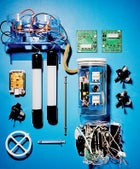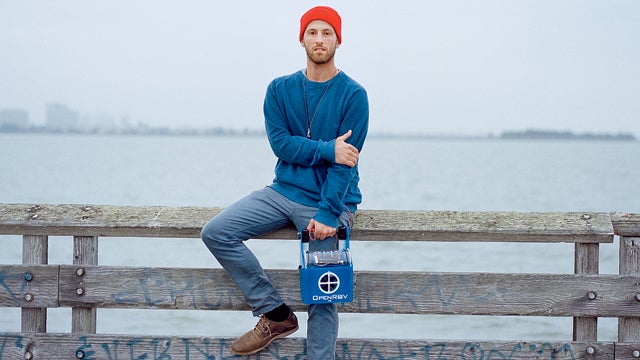DAVID LANG BEAMS proudly as a blue bread box carves tight figure eights through a large tank of water. It’s not actually a bread box. It’s a miniature, bread-box-ish submarine, controlled remotely from a nearby laptop. But Lang really is beaming, the way parents beam, or maybe the way you beam if all this is new and only recently you had no home or job or money, certainly no submarines, and were sleeping in your old Nissan Maxima down by the marina.
 OpenROV’s innards.
OpenROV’s innards.“This is my job,” he says. We’re standing in an airy old research lab at the edge of the San Francisco Bay. Robot parts lie here and there. Lang is talking to himself as much as to me. It’s an unguarded moment for the lanky cofounder of , a low-cost, open-source startup that has sold hundreds of underwater-submersible kits to scientists and amateur Jacques Cousteaus over the past year. A couple of colleagues are in the corner futzing with cables. There’s a good amount of laughing. This is indeed Lang’s job—he just got back from wowing the folks at the ’s research center and has written a book about his transformation, which will be published this fall.
Growing up in a small suburb of Minneapolis, Lang took a fairly normal path to a normal life: sports, decent grades, Catholic school, the University of Wisconsin, where he studied real estate. To ask what he wanted to do is to miss the point—his track required no such foresight. Periodically, his innate intensity would poke through, like when he talked his way into teaching sailing in Berkeley, California, after college—before learning how to sail. But the tractor beam of normalcy was powerful. By 2010, Lang was in his midtwenties and working at a Los Angeles startup called ProFounder, helping crowdfund small businesses. He sat in an office, wrote e-mail, and dealt with clients. “I kept having this feeling of missing the water,” says Lang, “but it was a perfectly good job.” Then one morning he was called into the conference room. Funding was tight; he was out.
Lang quickly sank to impressive depths. Not long after he was laid off, he was cashing unemployment checks, then living out of his car. His girlfriend dumped him. Things got dark—and Lang submitted to a wholesale reappraisal. “The only thing I knew how to do,” he says, “my only qualification, was to stare at a computer.”
He was inspired by a conversation with a carpenter, who, as Lang puts it, “had a skill no one could ever take away.” He enrolled in a public workshop, where he found solace in making things—a planter box, a cribbage board. Learning to use machines like a laser cutter got him through his days. That and a heap of gold in a cave up north.
Lang had heard about the gold from a charismatic young engineer he’d recently met named Eric Stackpole. While interning at in Mountain View, Stackpole told Lang a story about a couple of Native Americans who’d robbed a mining operation in the mid 1800s. On the run from lawmen, the robbers had allegedly chucked the loot into an underwater limestone cavern in Trinity County, California. Over the years, treasure hunters had tried to find the stash, but they could never dive deep enough. Cue the bread box.
Stackpole’s garage in Cupertino became headquarters. He and Lang began designing a submersible ROV (remotely operated vehicle) that might poke its way toward the treasure. Lang had never held a soldering gun, much less built an underwater drone. No matter. In the summer of 2012, he and Stackpole launched a Kickstarter campaign hoping to bring in $20,000. By the end of the funding period, they’d reached over $111,000 by selling the idea of affordable, accessible undersea exploration.
They didn’t find the gold; the sub’s camera only turned up a piece of tubing, some sunglasses, and an old lighter. But in OpenROV, Lang had something far better—an opportunity. The company’s business model was born of the Wikipedia age: for $830, you get a kit made from off-the-shelf parts and instructions from a community of fellow tinkerers who are constantly trying to improve the process. (Most ready-made ROVs cost thousands.) There was one rub, though: orders started rolling in as Stackpole was leaving on a research trip to Antarctica. Lang was suddenly the production end of OpenROV. “I had to become a manufacturer overnight,” he recalls. “I built 120 robots in four months. I would throw parties and just put everyone to work.”
The Tom Sawyer approach succeeded—20 volunteers showed up and the company was launched. OpenROV raised $1.5 million in venture capital. Enthusiasts from over 50 countries now hash out improvements to the robot. OpenROV’s online forums teem with spirited talk of improving ballast, adjusting the camera-tilt mechanism, and changing the electrical housing. (One subject of lively debate: the possibility of attaching a speargun to dispatch invasive lionfish.) “We didn’t build this,” Lang likes to say. “We curated it.”
Lang, now 28, was named a TED fellow this year, and in September tech publisher O’Reilly Media will release his first book, . But to hear Lang tell it, the best perk is freedom. Instead of a stuffy office, he now works in an innovator’s paradise. Instead of worrying about clients, he thinks about how to add more video cameras to OpenROV or improve its thrusters. Sure, he still sidles up to a computer, but strictly in service of, as he says, “a shitload of fun.”
Lang’s is a meta kind of joy. He’s aware of how unlikely his story is—and how lucky he was to face a career change in his late twenties. By rights he should be tapping away in some airless office. But he did the thing so many people in their thirties fantasize about but think is unrealistic: he rebooted his life. Lang calls it “riding the edge of what’s possible.” It’s the kind of line that could make you groan if it wasn’t so hard-won.
Back at the lab, Lang is checking out the sub’s new moves. Thanks to some crowdsourced improvements, it flies through the water more gracefully than ever. After a few burbles, the thing rises to the surface. Lang fishes it out and then just stands there, grinning into the water.
“There are still adventures to be had,” he says after a pause. “Growing up, I just didn’t know that.”
‘s next book, What to Talk About, comes out IN 2014.

